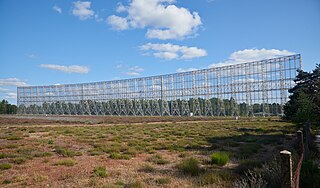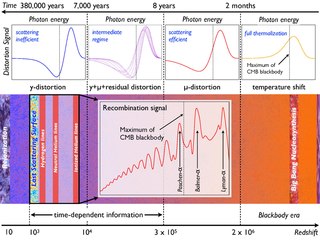
The cosmic microwave background is microwave radiation that fills all space in the observable universe. It is a remnant that provides an important source of data on the primordial universe. With a standard optical telescope, the background space between stars and galaxies is almost completely dark. However, a sufficiently sensitive radio telescope detects a faint background glow that is almost uniform and is not associated with any star, galaxy, or other object. This glow is strongest in the microwave region of the radio spectrum. The accidental discovery of the CMB in 1965 by American radio astronomers Arno Penzias and Robert Wilson was the culmination of work initiated in the 1940s.

The Wilkinson Microwave Anisotropy Probe (WMAP), originally known as the Microwave Anisotropy Probe, was a NASA spacecraft operating from 2001 to 2010 which measured temperature differences across the sky in the cosmic microwave background (CMB) – the radiant heat remaining from the Big Bang. Headed by Professor Charles L. Bennett of Johns Hopkins University, the mission was developed in a joint partnership between the NASA Goddard Space Flight Center and Princeton University. The WMAP spacecraft was launched on 30 June 2001 from Florida. The WMAP mission succeeded the COBE space mission and was the second medium-class (MIDEX) spacecraft in the NASA Explorer program. In 2003, MAP was renamed WMAP in honor of cosmologist David Todd Wilkinson (1935–2002), who had been a member of the mission's science team. After nine years of operations, WMAP was switched off in 2010, following the launch of the more advanced Planck spacecraft by European Space Agency (ESA) in 2009.
In the fields of Big Bang theory and cosmology, reionization is the process that caused electrically neutral atoms in the universe to reionize after the lapse of the "dark ages".

The hydrogen line, 21 centimeter line, or H I line is a spectral line that is created by a change in the energy state of solitary, electrically neutral hydrogen atoms. It is produced by a spin-flip transition, which means the direction of the electron's spin is reversed relative to the spin of the proton. This is a quantum state change between the two hyperfine levels of the hydrogen 1 s ground state. The electromagnetic radiation producing this line has a frequency of 1420.405751768(2) MHz (1.42 GHz), which is equivalent to a wavelength of 21.106114054160(30) cm in a vacuum. According to the Planck–Einstein relation E = hν, the photon emitted by this transition has an energy of 5.8743261841116(81) μeV [9.411708152678(13)×10−25 J]. The constant of proportionality, h, is known as the Planck constant.

The Square Kilometre Array (SKA) is an intergovernmental international radio telescope project being built in Australia (low-frequency) and South Africa (mid-frequency). The combining infrastructure, the Square Kilometre Array Observatory (SKAO), and headquarters, are located at the Jodrell Bank Observatory in the United Kingdom. The SKA cores are being built in the southern hemisphere, where the view of the Milky Way galaxy is the best and radio interference at its least.

The Giant Metrewave Radio Telescope (GMRT), located near Narayangaon, Pune in India, is an array of thirty fully steerable parabolic radio telescopes of 45 metre diameter, observing at metre wavelengths. It is the largest and most sensitive radio telescope array in the world at low frequencies. It is operated by the National Centre for Radio Astrophysics (NCRA), a part of the Tata Institute of Fundamental Research, Mumbai. It was conceived and built under the direction of Late Prof. Govind Swarup during 1984 to 1996. It is an interferometric array with baselines of up to 25 kilometres (16 mi). It was recently upgraded with new receivers, after which it is also known as the upgraded Giant Metrewave Radio Telescope (uGMRT).

The Submillimeter Array (SMA) consists of eight 6-meter (20 ft) diameter radio telescopes arranged as an interferometer for submillimeter wavelength observations. It is the first purpose-built submillimeter interferometer, constructed after successful interferometry experiments using the pre-existing 15-meter (49 ft) James Clerk Maxwell Telescope and 10.4-meter (34.1 ft) Caltech Submillimeter Observatory as an interferometer. All three of these observatories are located at Mauna Kea Observatory on Mauna Kea, Hawaii, and have been operated together as a ten element interferometer in the 230 and 345 GHz bands. The baseline lengths presently in use range from 16 to 508 meters. The radio frequencies accessible to this telescope range from 194–408 gigahertz (1.545–0.735 mm) which includes rotational transitions of dozens of molecular species as well as continuum emission from interstellar dust grains. Although the array is capable of operating both day and night, most of the observations take place at nighttime when the atmospheric phase stability is best.

The Low-Frequency Array, or LOFAR, is a large radio telescope, with an antenna network located mainly in the Netherlands, and spreading across 7 other European countries as of 2019. Originally designed and built by ASTRON, the Netherlands Institute for Radio Astronomy, it was first opened by Queen Beatrix of The Netherlands in 2010, and has since been operated on behalf of the International LOFAR Telescope (ILT) partnership by ASTRON.

An astronomical interferometer or telescope array is a set of separate telescopes, mirror segments, or radio telescope antennas that work together as a single telescope to provide higher resolution images of astronomical objects such as stars, nebulas and galaxies by means of interferometry. The advantage of this technique is that it can theoretically produce images with the angular resolution of a huge telescope with an aperture equal to the separation, called baseline, between the component telescopes. The main drawback is that it does not collect as much light as the complete instrument's mirror. Thus it is mainly useful for fine resolution of more luminous astronomical objects, such as close binary stars. Another drawback is that the maximum angular size of a detectable emission source is limited by the minimum gap between detectors in the collector array.

The Murchison Widefield Array (MWA) is a joint project between an international consortium of organisations to construct and operate a low-frequency radio array. 'Widefield' refers to its very large field of view. Operating in the frequency range 70–300 MHz, the main scientific goals of the MWA are to detect neutral atomic Hydrogen emission from the cosmological Epoch of Reionization (EoR), to study the sun, the heliosphere, the Earth's ionosphere, and radio transient phenomena, as well as map the extragalactic radio sky. It is located at the Murchison Radio-astronomy Observatory (MRO).

MeerKAT, originally the Karoo Array Telescope, is a radio telescope consisting of 64 antennas in the Meerkat National Park, in the Northern Cape of South Africa. In 2003, South Africa submitted an expression of interest to host the Square Kilometre Array (SKA) Radio Telescope in Africa, and the locally designed and built MeerKAT was incorporated into the first phase of the SKA. MeerKAT was launched in 2018.

The Australian Square Kilometre Array Pathfinder (ASKAP) is a radio telescope array located at Murchison Radio-astronomy Observatory (MRO) in the Mid West region of Western Australia.
The Donald C. Backer Precision Array for Probing the Epoch of Reionization (PAPER) is a radio interferometer funded by the National Science Foundation to detect 21 cm hydrogen (HI) fluctuations occurring when the first galaxies ionized intergalactic gas at around 500 Million years after the Big Bang. PAPER is a focused experiment aimed toward making the first statistical detection of the 21 cm reionization signal. Given the stringent dynamic range requirements for detecting reionization in the face of foregrounds that are five orders of magnitude brighter, the PAPER project is taking a carefully staged engineering approach, optimizing each component in the array to mitigate, at the outset, any potentially debilitating problems in subsequent data calibration and analysis. This staged approach addresses the observational challenges that arise from very-wide-field, high-dynamic-range imaging over wide bandwidths in the presence of transient terrestrial interference. PAPER began as a collaboration between Don Backer of the UC Berkeley Radio Astronomy Laboratory and Richard Bradley of the National Radio Astronomy Observatory. With Backer's passing in 2010, Aaron Parsons has assumed leadership of PAPER on the side of UC Berkeley.
Wouthuysen–Field coupling, or the Wouthuysen–Field effect, is a mechanism that couples the excitation temperature, also called the spin temperature, of neutral hydrogen to Lyman-alpha radiation. This coupling plays a role in producing a difference in the temperature of neutral hydrogen and the cosmic microwave background at the end of the Dark Ages and the beginning of the epoch of reionization. It is named for Siegfried Adolf Wouthuysen and George B. Field.
The Large-Aperture Experiment to Detect the Dark Ages (LEDA) is designed to detect the spectrum of the 21 cm Hydrogen line from the Intergalactic Medium (IGM) at redshifts of 15–30, when the Universe was just ~1% of its present age. It is located at the Long Wavelength Array site, adjacent to the Very Large Array. LEDA principally comprises a "large-N" array correlator, calibration & imaging system, and instrumentation for measurement of calibrated total-power. These systems will use the station 1 of the Long Wavelength Array as an aperture. LEDA is one of several efforts seeking to study cosmological reionization and the preceding Dark Ages. Others include the Precision Array for Probing the Epoch of Reionization (PAPER), Low Frequency Array (LOFAR), Murchison Widefield Array (MWA), and Giant Metrewave Radio Telescope (GMRT). LEDA will feature array-based calibration to improve the accuracy of foreground subtraction from the total-power signal. The project received funding from the National Science Foundation in August 2011.
The Dark Ages Radio Explorer (DARE) mission is a proposed concept lunar orbiter intended to identify redshifted emanations from primaeval hydrogen atoms just as the first stars began to emit light. DARE will use the precisely redshifted 21-cm transition line from neutral hydrogen to view and pinpoint the formation of the first illuminations of the universe and the period ending the Dark Ages of the universe. The orbiter will explore the universe as it was from around 80 million years to 420 million years after the Big Bang. The mission will deliver data pertaining to the formation of the first stars, the initial black hole accretions, and the reionization of the universe. Computer models of galaxy formation will also be tested.
In cosmology, intensity mapping is an observational technique for surveying the large-scale structure of the universe by using the integrated radio emission from unresolved gas clouds.

The Nançay Radio Observatory, opened in 1956, is part of Paris Observatory, and also associated with the University of Orléans. It is located in the department of Cher in the Sologne region of France. The station consists of several instruments. Most iconic of these is the large decimetric radio telescope, which is one of the largest radio telescopes in the world. Long established are also the radio heliograph, a T-shaped array, and the decametric array operating at wavelengths between 3 m and 30 m.

The Experiment to Detect the Global EoR Signature (EDGES) is an experiment and radio telescope located in a radio quiet zone at the Murchison Radio-astronomy Observatory in Western Australia. It is a collaboration between Arizona State University and Haystack Observatory, with infrastructure provided by CSIRO. EoR stands for epoch of reionization, a time in cosmic history when neutral atomic hydrogen gas became ionised due to ultraviolet light from the first stars.

CMB spectral distortions are tiny departures of the average cosmic microwave background (CMB) frequency spectrum from the predictions given by a perfect black body. They can be produced by a number of standard and non-standard processes occurring at the early stages of cosmic history, and therefore allow us to probe the standard picture of cosmology. Importantly, the CMB frequency spectrum and its distortions should not be confused with the CMB anisotropy power spectrum, which relates to spatial fluctuations of the CMB temperature in different directions of the sky.















